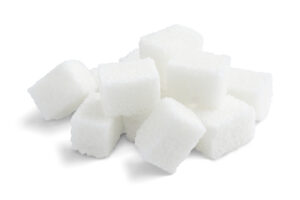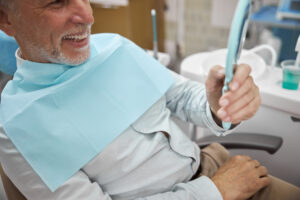Header logo
header top contact widget
Learn More Blog
Be “Sweet” To Your Smile By Monitoring Sugar Intake
Posted on Aug 31, 2021 by William J. Claiborne, DDS MS
If Americans truly calculated the amount of sugar they’ve consumed at the end of each day, I believe most would be shocked. Even unintentionally, sugar intake can easily reach levels that are far beyond what is assumed.
For example, in a 2015 Washington Post article, it was reported that 25 percent of catsup is sugar. Alarmingly, one tablespoon has four grams of sugar, which is more sugar than a typical chocolate chip cookie.
The World Health Organization (WHO) recommends a maximum of no more than 10 teaspoons of free sugars per day. Regardless of age, the WHO advises keeping daily sugar consumption to less than 10 percent of calories “to reduce the risk of unhealthy weight gain and dental caries.”
However, our goal in limiting sugar is often sabotaged by hidden sugars.
Sugar comes in far more forms than just the white or brown bags of granular “cane sugar” we purchase in the grocery store. If you read the list of ingredients in foods and beverages, you may be surprised at how many forms of sugar are concealed with different names. At this time, there are more than sixty.
Here’s how to catch some of them:
Added sugar may be listed as syrup (examples are corn syrup or rice syrup) or anything with an ingredient that ends in “ose” (such as fructose, sucrose, maltose, dextrose). Other examples of added sugar include fruit nectars, juice concentrates, honey, agave and molasses.
Ideally, the WHO urges an intake of no more than 6 teaspoons (or less than 5 percent) of sugars per day to “provide additional health benefits.” This is an ambitious goal for Americans who have become literally addicted to sugar.
In a study of lab rats who were provided with a diet of food and intermittent supplies of sugar water, the results showed indications of addiction and symptoms of withdrawal. https://www.sciencedirect.com/science/article/abs/pii/S0149763407000589?via%3Dihub
The study spurned on a succession of additional studies. In one, it was noted that sugar “lights up” the same area of the brain as cocaine.
https://www.businessinsider.com/sugar-has-a-similar-effect-on-the-brain-as-cocaine-2016-4
As a periodontist, I’m especially concerned about sugar intake to the detriment of oral health. Sugar lowers the natural pH levels in saliva and triggers a process that is the beginning of tooth demineralization. Demineralization describes the process where the enamel and tooth structures are dissolved.
Although sugar is not a healthy food choice for any part of the body, it is important to remember that it is the mouth that is the entry point for what we eat or drink. Thus, the destructive nature of sugar begins by causing an imbalance in the mouth through altering the healthy formulation of saliva.
For a minute, think of the foods you consumed yesterday. Coffee with sweetened creamer? Toast with jam? Sweet tea with lunch? A candy bar and cola as a mid-afternoon snack? Catsup over your fries at dinner, followed by a bowl of ice-cream?
When we are conscious of just how much sugar is being consumed over the course of a day, it becomes easier to make better choices. As we taper down little by little, it actually helps us to “wean” off the dependency of sugar so it doesn’t feel like deprivation.
As an Asheville Periodontist, I see patients every day who have periodontal disease, cavities and missing teeth that can be attributed to diet, smoking and insufficient oral hygiene. Many face involved treatment decisions that can be costly and take months to accomplish.
Although we pride ourselves on providing our patients with a comfortab
le experience backed by advanced skills and technology, so much of our treatment can be prevented with easy proactive measures. Eating a healthy diet, keeping the mouth moist, brushing and flossing, and seeing a dentist regularly are all practical ways to keep a healthy, confident smile.
Yet, “we don’t know what we don’t know.” Because our population is largely unaware of the extent of sugars in many foods and beverages, it is easy to consume far more than is realized.
 Take charge of your oral health by reading food labels, meal planning that limits sugars, and being highly committed to your oral hygiene routine at home. A few tips for a healthy mouth between dental check-ups are:
Take charge of your oral health by reading food labels, meal planning that limits sugars, and being highly committed to your oral hygiene routine at home. A few tips for a healthy mouth between dental check-ups are:
• Brush twice a day (at least) for two minutes each time. Use a fluoride toothpaste with a soft to medium bristle toothbrush.
• Floss your teeth every day before your brush to dislodge food particles caught between teeth. If flossing is difficult for you, try one of the water flossers. These are affordable and as effective as manual flossing.
• Brush your tongue after your teeth to unroot embedded bacteria, especially reaching the back area of the tongue (where most bacteria are embedded).
• Use an oral rinse that replenishes moisture twice a day (or as directed). These are available at most drug stores.
• Chew sugarless gum, preferably a brand that contains Xylitol. Xylitol looks and tastes like sugar, yet has 40 percent fewer calories.
• Drink plenty of water throughout the day. Be aware that beverages such as most coffee, tea and colas contain caffeine are drying to the mouth. Many medications also have the side effect of oral dryness – another good reason to stay hydrated.
Also, be aware of the signs and symptoms of gum disease. Sore, tender, bleeding, swollen or red gums are all warning signs. With prompt measures, we can greatly minimize treatment needs to rid your mouth of this dangerous bacteria that has been associated with a number of serious health problems (including stroke and some cancers).
If you haven’t seen your general dentist on a regular basis, call 828-274-9440. Our Asheville periodontal office can help to restore your mouth to a healthy state with the most conservative, yet effective, treatment possible.
Recent Posts
Categories
Archives
- September 2024
- August 2024
- July 2024
- June 2024
- May 2024
- April 2024
- March 2024
- February 2024
- January 2024
- December 2023
- November 2023
- October 2023
- September 2023
- August 2023
- July 2023
- June 2023
- May 2023
- April 2023
- March 2023
- February 2023
- January 2023
- December 2022
- November 2022
- October 2022
- September 2022
- August 2022
- July 2022
- June 2022
- May 2022
- April 2022
- March 2022
- February 2022
- January 2022
- December 2021
- November 2021
- October 2021
- September 2021
- August 2021
- July 2021
- June 2021
- May 2021
- April 2021
- March 2021
- February 2021
- January 2021
- December 2020
- November 2020
- October 2020
- September 2020
- August 2020
- July 2020
- June 2020
- May 2020
- April 2020
- March 2020
- February 2020
- January 2020
- December 2019
- November 2019
- October 2019
- September 2019
- August 2019
- July 2019
- June 2019
- May 2019
- April 2019
- March 2019
- February 2019
- January 2019
- December 2018
- November 2018
- October 2018
- September 2018
- August 2018
- July 2018
- June 2018
- May 2018
- April 2018
- March 2018
- February 2018
- January 2018
- December 2017
- November 2017
- October 2017
- September 2017
- August 2017
- July 2017
- June 2017
- May 2017
- April 2017
- March 2017
- February 2017
- January 2017
- December 2016
- November 2016
- October 2016
- September 2016
- August 2016
- July 2016
- June 2016
- May 2016
- April 2016
- March 2016
- February 2016
- January 2016
- December 2015
- November 2015
- October 2015
- September 2015
- August 2015
- July 2015
- June 2015
- May 2015
- April 2015
- March 2015
- February 2015
- January 2015
- December 2014
- November 2014
- October 2014
- September 2014
- August 2014
- July 2014
- June 2014
- May 2014
- April 2014
- March 2014
- February 2014
- January 2014
- December 2013
- November 2013
- October 2013
- September 2013
- August 2013
- July 2013
- June 2013
- May 2013
- April 2013
- March 2013
- February 2013
- January 2013
- December 2012
- November 2012
- October 2012
- September 2012
- August 2012
- July 2012
- June 2012

